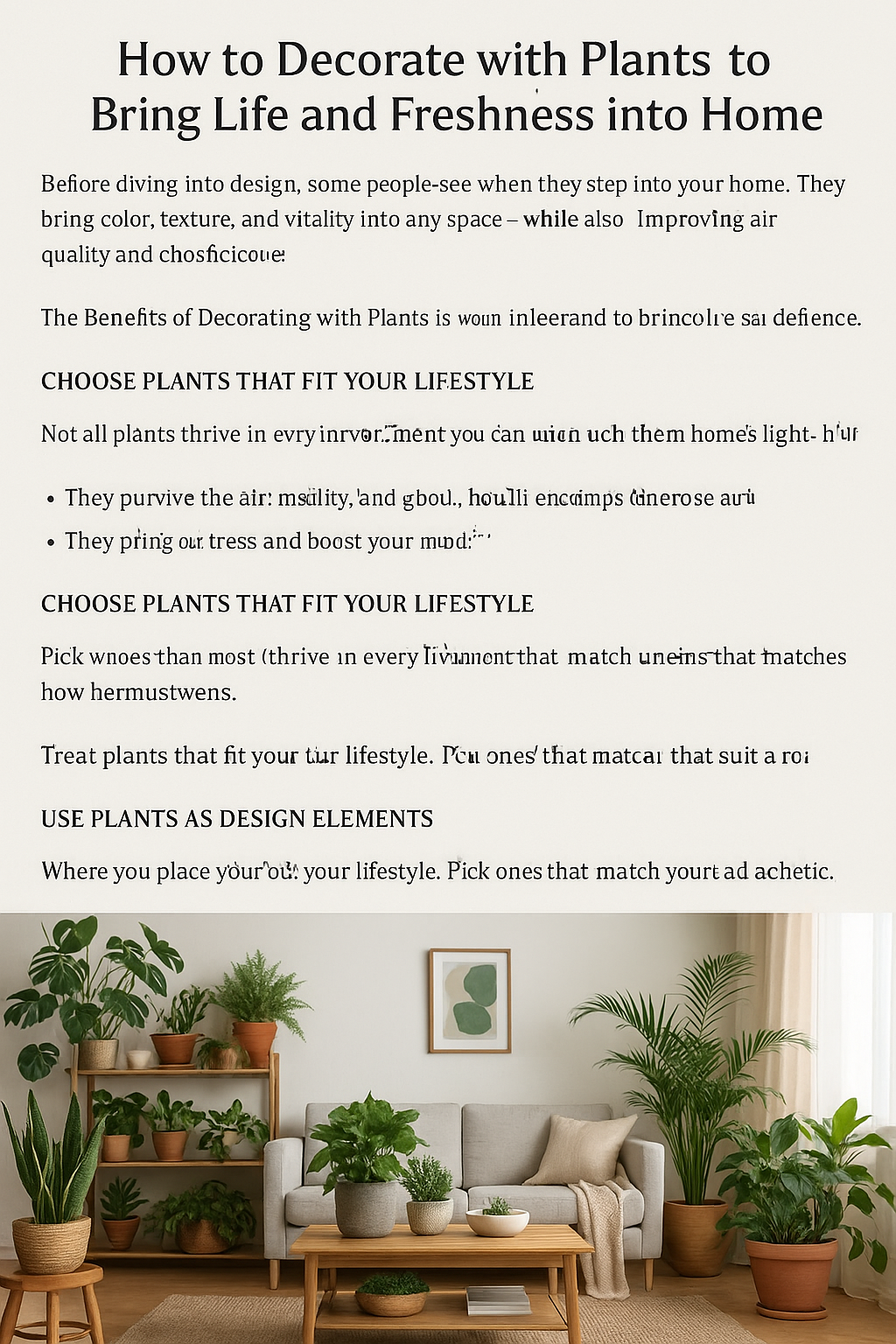Plants are one of the most transformative elements you can add to your home decor. They bring color, texture, and vitality into any space — while also improving air quality and enhancing your well-being. Whether you have a large home filled with sunlight or a small apartment with limited light, decorating with plants can make your interiors feel more vibrant, relaxing, and alive.
Neste artigo, você vai aprender como escolher, posicionar e combinar plantas para que elas se tornem parte essencial da decoração da sua casa.
The Benefits of Decorating with Plants
Before diving into design, it’s worth understanding why plants make such a difference.
- They purify the air: Many indoor plants filter toxins and improve air circulation.
- They reduce stress: Studies show plants promote relaxation and boost mood.
- They bring natural beauty: Greenery softens interiors and complements every decor style.
- They connect you with nature: Especially important in urban environments.
- They’re versatile: Fit in every room — from living rooms to bathrooms.
Plants bring life, literally and visually, into your home.
Choose Plants That Fit Your Lifestyle
Not all plants thrive in every environment. Pick ones that match your home’s light, humidity, and your maintenance habits.
- Low-maintenance plants: Snake plant, pothos, ZZ plant, or peace lily. Perfect for beginners.
- Sun-loving plants: Succulents, cacti, jade plant, and aloe vera — great for bright spots.
- Shade-tolerant plants: Ferns, philodendrons, and calatheas for lower light rooms.
- Air-purifying plants: Spider plants, rubber plants, and dracaenas.
- Statement plants: Monstera, fiddle-leaf fig, or palms for visual impact.
Choose plants that suit your lifestyle — not the other way around.
Use Plants as Design Elements
Plants can be more than background decor; they can define a room’s aesthetic.
- As focal points: A large plant like a fiddle-leaf fig can anchor a living room.
- As texture: Ferns or trailing vines add movement and softness.
- As pattern: Variegated leaves, like calatheas or peperomias, add natural art.
- As symmetry: Matching plants on both sides of a sofa or console table create balance.
Treat plants like you would artwork or furniture — as integral design features.
Experiment with Placement
Where you place your plants affects both their growth and visual impact.
- Corners: Tall plants fill empty corners beautifully.
- Shelves and bookcases: Small trailing plants like ivy or pothos add charm.
- Windowsills: Great for succulents and herbs that crave sunlight.
- Bathrooms: Ferns and orchids thrive in humidity.
- Bedrooms: Snake plants and lavender improve air quality and relaxation.
Vary height and depth for a more organic, layered look.
Mix Different Sizes and Shapes
A mix of plant sizes adds depth and movement to interiors.
- Combine tall floor plants with small tabletop plants.
- Group round-leaf plants with spiky or vine-like types.
- Use trailing plants to soften shelves and edges.
- Add clusters of three plants for natural balance.
Visual variety prevents a flat or overly uniform appearance.
Choose Stylish Planters
The pot is as important as the plant itself.
- Ceramic pots: Elegant and timeless for living rooms.
- Terracotta pots: Warm and rustic, perfect for natural looks.
- Metal or concrete pots: Ideal for modern, industrial spaces.
- Woven baskets: Great for bohemian or coastal styles.
- Hanging planters: Save space and add vertical interest.
Match your planter style with your home’s decor theme.
Use Plants to Define Spaces
Plants can act as natural dividers, especially in open-plan homes.
- Use tall palms or bamboo plants to separate dining and living areas.
- Create green corners as cozy nooks or reading spots.
- Place plants along hallways or staircases to guide flow.
- Use shelving units filled with plants as visual partitions.
They define zones without adding physical barriers.
Combine with Other Natural Materials
Plants shine when surrounded by other organic elements.
- Use wooden furniture or rattan chairs to enhance natural warmth.
- Add linen or cotton textiles for softness.
- Pair with stone, clay, or jute accents for an earthy feel.
- Combine greenery with neutral color palettes for harmony.
Nature-inspired decor feels grounded and timeless.
Keep Maintenance in Mind
Healthy plants are beautiful plants.
- Water consistently, but avoid overwatering.
- Wipe leaves to remove dust and help them breathe.
- Rotate plants occasionally so they grow evenly.
- Fertilize every few weeks for lush growth.
- Repot annually to give roots room to expand.
A few minutes of care weekly keeps your indoor garden thriving.
Play with Seasonal Updates
Plants can help you refresh your home throughout the year.
- Spring: Add flowering plants or fresh herbs.
- Summer: Go for tropical plants and bright greenery.
- Autumn: Bring in earthy-toned pots and dried arrangements.
- Winter: Focus on evergreens or minimalist displays.
Rotate or rearrange plants to match seasonal moods.
Final Thoughts: Nature Indoors, Harmony at Home
Decorating with plants is about more than aesthetics — it’s about creating balance between life and design. Whether you prefer minimalist greenery or a lush indoor jungle, plants make your home feel alive, calm, and connected to nature.
By choosing the right species, experimenting with placement, and integrating natural materials, you can design a space that breathes — literally and visually.
A touch of green isn’t just decoration; it’s a way of bringing peace, freshness, and vitality into your daily life.
